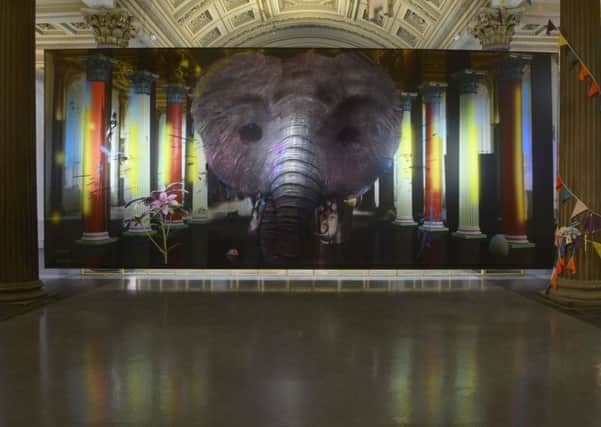Art review: Glasgow International - Director's Programme


Facing you as you walk into the gallery is a photograph of an elephant by artist John Russell, printed on an elephant-sized canvas. Made to look as if it has been taken in this very space, it is meant to trick the eye. Can we tell the difference between the image and reality, the cyber world and the real one? Is this the 21st-century elephant in the room?
The preoccupations laid out here are not new, as we see in Lynn Hershman Leeson’s 1994 film, Seduction of a Cyborg. In it, a woman becomes addicted to having technological modifications made on her own body until it robs her of her immunity, and, eventually, her life. While the computers in the film look boxy and dated, the sentiments are as prescient as ever.
Advertisement
Hide AdIrish artist Sam Keogh has created a performance-installation in which he takes the role of an astronaut waking up disorientated in a badly damaged cryptopod. This “space ship” is nothing like the clean, high-tech environment we expect from science-fiction movies; this is technology which is vulnerable, which might take us beyond our capacity to survive.
We see people trying on other selves, imagining other futures, from Mai-Thu Perret’s guerilla feminists founding a patriach-free utopia in the desert, to a man trying on a woman’s identity in Jamie Crewe’s fascinating film. Jessie Darling’s washing lines, strung about the gallery with baby clothes, tea towels and dreamcatchers, are a welcome reminder that it is the most mundane things which root us in real life.
An online avatar of American artist and sound designer E.Jane features too, talking to her “cyber friends”, “travelling” on Google Earth and selling branded products with a kind of bored superficiality. Her larger work, Lavendra (***), at Kelvin Hall, is more playful. “Lavendra” is a brown dwarf, a star which lacks the mass to ignite and produce starlight, but E.Jane’s performing alter-ego MHYSA aims to make it (her?) a star again by harnessing the glam of black divas down the decades. To this end, she has made a space full of sequined banners and pop video collages, bathed in lavender light.
Self-Loathing Flashmob by Glasgow-based Hardeep Pandhal (****), at the same venue, has a much harder edge. The large-scale cartoon figures downstairs, defaced with graffiti and with an acerbic rap track to accompany them, are upstairs meshed with film footage taken during a 2010 student protest against higher education fees. It’s darkly humorous, shot through with a kind of angry nihilism, the mouthpiece of a generation who anticipate little from their future but debts and call centre jobs.
The cartoon aesthetic, which crops up several times in the festival, is rather more benign in Mick Peter’s The Regenerators (***), a 90m-long billboard mural made in collaboration with young people on the side of a former gas purifying shed in Dalmarnock. His detailed, well-crafted drawing, with additional “scenes” which can be glimpsed through the gaps, plays on the idea of “regeneration” with clear-sightedness and humour.
Winner of the 2017 Turner Prize, Lubaina Himid has created a sculpture for GI in the central hall at Kelvingrove Museum with the rather ponderous title of Breaking in. Breaking out. Breaking up. Breaking down (**). Himid is an artist with a fascinating career but this work – a suspended train carriage with dragons painted on it – does little to convey this. While the accompanying text works hard to convince that it captures notions of “exchange, circulation or migration”, it seems to me to be going nowhere fast.
Advertisement
Hide AdMeanwhile, at Tramway, Mark Leckey’s Nobodaddy (***) returns to the idea of avatars and technology. Another Turner Prize winner, Leckey has taken a small 18th-century figure from the Wellcome Collection, believed to depict the biblical character Job, enlarged it to larger-than-human proportions and filled its hollow insides with a 7.1 surround sound audio system. This tortured-looking figure exerts a powerful presence in the vast, dark space of Tramway 2, and Leckey has given him a voice, yet it feels like a missed opportunity that he has not been given more compelling things to say.
Another venue, another avatar: at Film City, artist Stephen Sutcliffe and theatre director Graham Eatough have joined forces to create No End to Enderby (****), adapting for film two chapters from Anthony Burgess’ Enderby novels (the character is sometimes described as Burgess’ alter-ego). In Inside Mr Enderby, a schoolmaster takes his class on a time-travelling trip to visit the revered poet they have been studying, and in The Muse, an academic travels back in time to interview Shakespeare and find out, once and for all, if he really did write all those plays.
Advertisement
Hide AdThey are well-crafted films which capture the strangeness of the books today – both retro and futuristic at the same time – and ask a pile of fascinating questions about art and reputation, and the perhaps unwise veneration of literary (and artistic) heroes.
Cellular World until 7 October; Mark Leckey until 15 July; all other shows until 7 May, www.glasgowinternational.org